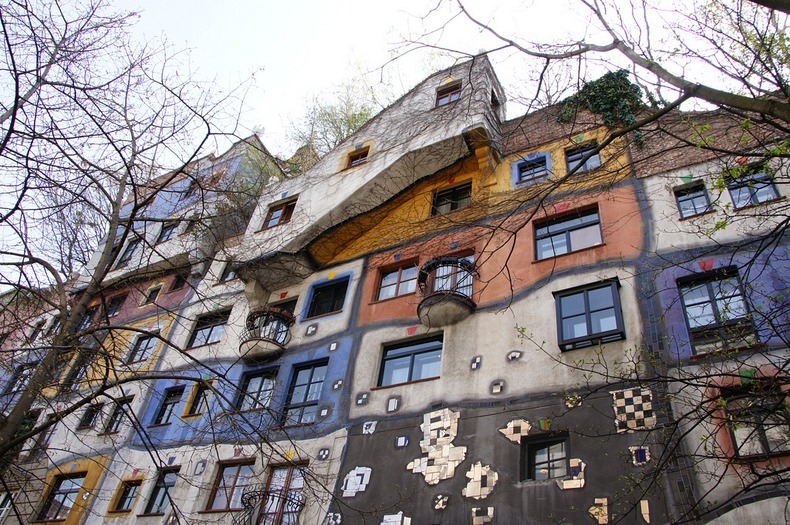Friedensreich Hundertwasser (1928–2000) was an Austrian painter, architect, and sculptor best known for his architecture characterized by colorful, ornamental, and biomorphic shapes. He initially gained acclaim for his paintings, but later became more renowned for his unique architectural styling.
Inspired by the Vienna Secession movement, especially the work of Austrian painters Egon Schiele and Gustav Klimt, Hundertwasser incorporated his decorative, labyrinthine spirals into his paintings, architecture and designs for postage stamps and flags. He developed his own theory of “transautomatism”, which was inspired by the Surrealist concept of automatism (painting or drawing without conscious self-censorship), and sought to loosen the rigid rules of conventional art to emphasize the viewer’s experience. Hundertwasser's architectural style is often compared with those of Antoni Gaudi.
In the 1950s, Hundertwasser began designing architectural projects. These designs use irregular forms, and incorporate natural features of the landscape. The Hundertwasserhaus apartment block in Vienna is one famous example. This building has undulating floors, a roof covered with earth and grass, and large trees growing from inside the rooms, with limbs extending from windows. He took no payment for the design of Hundertwasserhaus, declaring that the investment was worth it to "prevent something ugly from going up in its place".
Hundertwasser was against monotonous architecture, and called for a boycott of architecture with straight lines, and demanded instead creative freedom of building, and the right to create individual structures. He wrote manifestos and essays and organized demonstrations. During the late 1960s he gave a series of attention-grabbing naked speeches advocating for an individual’s right to construct his or her own house.
As Hundertwasser’s reputation spread, more commissions arrived, including buildings as diverse as a church in the south of Austria, the railway station in Uelzen, Germany, a winery in the Napa Valley, California and the Hundertwasser toilet in Kawakawa. Hundertwasser's revolutionary architectural ideas also include topping buildings with trees and areas where animals can graze, and creating floor surfaces that are unlevel. His radical philosophies and outrageous antics attracted considerable attention from the public.
Hundertwasser House, Vienna, Austria Photo credit

Hundertwasser House, Vienna, Austria Photo credit
Hundertwasser House, Vienna, Austria Photo credit
Hundertwasser House, Vienna, Austria Photo credit
Grüne Zitadelle in Magdeburg, Germany Photo credit
Grüne Zitadelle in Magdeburg, Germany Photo credit
Grüne Zitadelle in Magdeburg, Germany Photo credit
Kuchlbauer-Turm, Abensberg, Germany Photo credit
Hundertwasser House, Germany Photo credit
Hundertwasserhaus Waldspirale, Darmstadt, Germany Photo credit
Hundertwasserhaus Waldspirale, Darmstadt, Germany Photo credit
Hundertwasser School, Wittenberg Photo credit
Hundertwasser School, Wittenberg Photo credit
Sources: Wikipedia, Livingnow, Artnet

























Now we know who built Whoville
ReplyDeleteFascinating, beautiful architecture !
ReplyDeletepretty good
ReplyDeleteWe first discovered & visited Hundertwasserhaus about fifteen years ago. We were in Vienna in December to visit the fantastic Christmas markets and decided to swing by thinking we could get a few great photos to put on Instagram.
ReplyDeleteWe were rather disappointed to see that the building looks really dull and faded - it looks like it hasn't been painted anytime since our last visit. When we first visited it was really colourful, bold & beautiful, so hope it gets a fresh coat of paint soon.